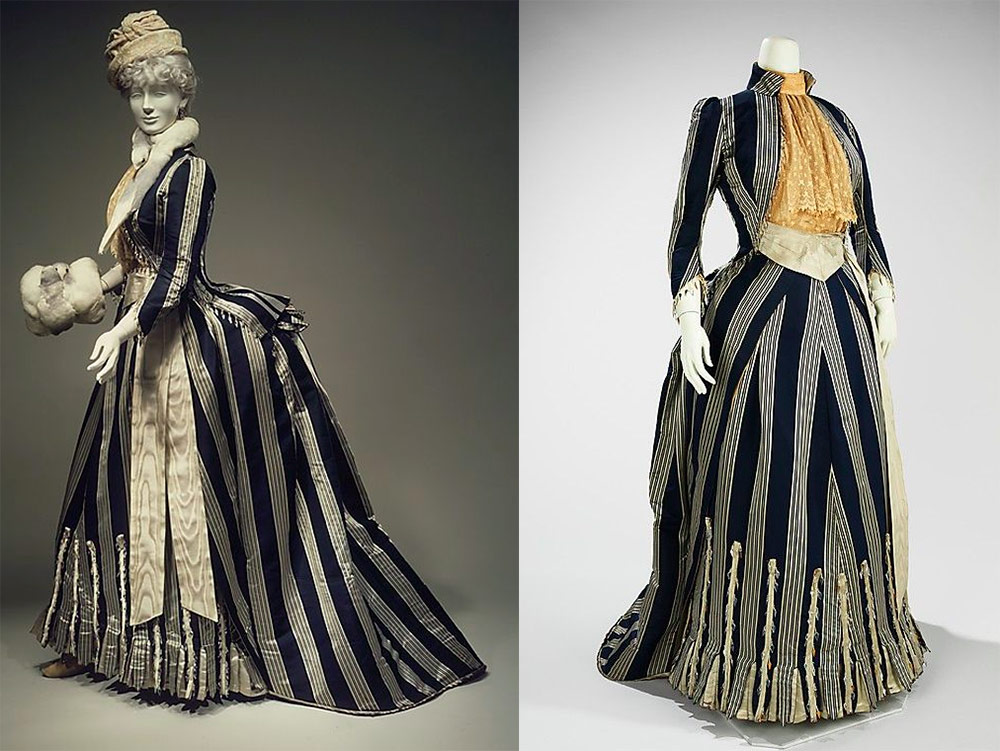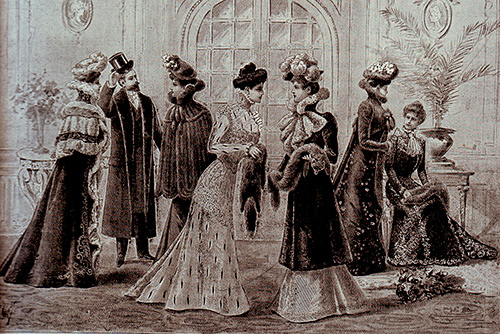Fashion history
Fashion and style of the 1880s
In the first half of the 1880s, costume masters created one of the most successful works of their art. Heavy and uncomfortable crinolines, which changed female proportions, creating unnatural shapes, were replaced by a suit, from which all unnecessary things were removed. The female figure has freed herself from ridiculous and sometimes disfiguring forms and formations.
The costume masters of the 1880s presented the female figure in harmony given to her by nature. The main role belonged to the corset, but already of such a design, in which the imitation of the natural lines of the body was provided, with some improvement in the figure. The corset completely wrapped around the torso, giving shape and defining the natural location of the waistline and hips.


In the dress of the first half of the 1880s, the fabric fitted tightly to the corset, repeating its flowing lines. Sculptural purity and expressiveness of the image were created. Dresses for any purpose during this period are made both in front and in the back of the same length, leaving the shoe visible, however, a small tren was formed at the back (the same as the train).
In elegant dresses, the length was increased, its rich decoration just testified to the purpose of the dress. Tren, to some extent, bore a resemblance to a mermaid's tail. A loop was sewn at the back, which was put on the wrist, which made it possible to control this "tail" by moving it to the left or right when moving.
"(Anninka) appeared in the dining room for tea in a magnificent silk dress, rustling with a trench and very skillfully maneuvering it among the chairs." (Saltykov-Shchedrin, Lord Golovlevs).

Pierre Auguste Renoir "Dance at Bougival"

Pierre Auguste Renoir "Dance in the City"
Sufficient skill, and maybe art, was required to move, dodge, dodge along with this unusual "tail".
When reviewing the fashion of that time, it is often called "nude fashion", "nude dress". Such definitions were often used to explain the place given to women in that bourgeois world. And in the best works of literature and painting one could see and read about the position of women of that time.
Auguste Renoir introduces us to lovely women, dressed in the latest fashion, in dresses that presented a beautiful body as a value that she possessed. Guy de Maupassant and Émile Zola in their literary works tell not only about the life of bourgeois society, they simultaneously describe the costumes of the characters. These descriptions help us appreciate how important the tailor's skill was in creating an attractive image that a woman was proud of, and how often the perfection of this shell was used as a trade for her body.

Charles Guiron "Parisienne"
“… She was wearing a pale blue cashmere dress that clearly outlined her slender waist and high breasts. Bare arms and neck protruded from the foam of white lace, which trimmed the bodice and short sleeves ... ". "... A dark, very simple dress fitted and outlined her entire figure." "Rene wore a neckline with such contempt for prying eyes, so much calmness and tenderness was in her nakedness ... men pushed forward to see ... this flower, created for bliss, with satin skin and the nakedness of a statue ...".
Critics of that time noticed that the paintings of Auguste Renoir have a close connection with the reality, which is told in the painting about the Parisian women of that time. Women's images created by Renoir can still serve as a creative inspiration for modern designers today.
It was at this time that one of the most exquisite cuts of women's dresses was the cut of "princesses". It was often made from Valenciennes lace, velvet or organdy (thin soft cotton fabric, slightly denser than muslin).

Pierre Auguste Renoir "On the Terrace"
To sculpt a sculptural statue, dressed in a costume of that era, a great skill of a tailor was required, since the cut of the first half of the 1880s, which seemed simple, consisted of many details. Skirts were often multi-layered with draperies, pleats, and trenches. The costume was complemented by all sorts of decorative elements and accessories - frills, muffs, handbags, hats, gloves, umbrellas, etc.
The hats were with a small crown and wide brim lowered. They were decorated with ostrich feathers and artificial flowers.


It would seem that the fashion of the first half of the 1880s was tuned in to the natural forms of the body, to the aesthetic values of the female figure, and subsequently everything should only be improved, however ...
The fashion of the next five years crossed out all the acquisitions and creations of the previous one ... The bustle returned again.


Fashion of the second half of the 1880s
In the second half of the 1880s, the bustle not only returned, but also acquired a fantastic shape. He became more bizarre in design, creating unnatural lines and proportions in the female figure. The suit had a high-closed bodice, almost under the very chin, with a long snip, the sleeves were often narrow or 3/4 long, the upper body was visually elongated.
The living conditions of that time with public urban transport and already working women, forced to shorten the skirt. Now, both in smart and casual clothes, the hem of the skirt exposed almost the entire shoe. The skirt was a bulky mass with many frills, ruffles and draperies falling from the bustle.


The whole face of the woman looked caricatured. The proportional relationship between top and bottom was violated, a huge bustle was discordant with a strict bodice and protruded from the back almost at right angles to the female figure, creating the impression of a huge box behind the back of the fashionista. This is how the artistic perfection of forms was imagined at that time. A hail of caricatures rained down on such excess pomp. The sane public, or, as they call it today, thinking people were extremely outraged by such structures.
Internal bustle designs in the 1880s were significantly lighter than those worn by ladies in the first half of the 1870s. They were various wire compositions fixed on a metal belt, with the help of which the bustle was in a horizontal position.
At this time, the art of trimmings flourished. Bason from the French passement - braid, braid. The costumes are enriched with decorative elements in the form of tassels, fringe, cord, braid, pompons, often patterned and braided. All these details were made of various materials, braided with silk and embroidered with beads - all this brought beauty and sophistication.


Decorative compositions favorably set off the texture of a variety of fabrics. And most of all, fashionistas decorated their bustle, making it even more cumbersome. It would seem that quite recently, just a couple of years ago in the first half of the 1880s, one could admire the beauty and plasticity of the female body, natural flowing lines and harmonious proportions, and now - causing ridiculous forms of a bustle, similar to a sofa attached to a fashionista.
Sleeves are often double-seamed, gathered around the rim and slightly raised above the shoulder. This was a tendency towards an increase in the sleeve head. In the future, already in the 1890s, it will receive the greatest development, turning now the sleeve into immense forms.
The corset in the second half of the 1880s also had the purpose of highlighting the bust, waist and smoothly emphasizing the hips. The huge bustle required balancing it with a counterweight - a large bust. Some of the fashionistas needed to create it with spacers or visually - with a strongly tightened waist.

They also noticed the linen, it was made of the finest cambric, trimmed with the finest Valenciennes lace. The trousers ended under the knee and lay close to the legs; they had embroidered shuttlecocks or lace on them. Silk stockings were gray, pearl, or flesh-colored. Petticoats made of muslin were worn by several pieces at once.

Sarah Bernhardt
At that time, the theater was for many not only a cultural entertainment, but also a place to showcase their unusual toilets, and therefore the talents of tailors. The theater was both a fashion laboratory and its catwalk.
During this period, art critics were simply obliged to talk not so much about the acting as about the costumes in which they were dressed. The audience itself attached importance to this. Actresses boldly demonstrated new items, provoked scandals and trends. The main style icon of the 1880s, and for many subsequent years, was Sarah Bernhardt.



Tell friends:
Comments and Reviews
Add a comment
Rating news
Shades of clothing that make women look younger
What shades of hair make women younger: rules and photos
Funny wedding dresses - photos and ideas
12 most expensive down jackets for the winter
How to look 25 at 40: tips from supermodels
Beautiful schoolgirls
Anti-aging haircuts and hairstyles for women
Fashionable skirts for autumn and winter
Fashionable women's trousers for the cold season
Fashionable and stylish sandals for summer 2020
Spring-summer 2021
 Fashionable dresses and tops with thin spaghetti straps
Fashionable dresses and tops with thin spaghetti straps
 Bandana tops: how to wear stylishly and beautifully
Bandana tops: how to wear stylishly and beautifully
 How to put together the perfect men's wardrobe for the summer
How to put together the perfect men's wardrobe for the summer
 Fashionable shorts for spring-summer 2021
Fashionable shorts for spring-summer 2021
 Fashionable skirts for spring-summer 2021: a guide to online shopping
Fashionable skirts for spring-summer 2021: a guide to online shopping
 The most fashionable dresses spring-summer 2021: styles and colors
The most fashionable dresses spring-summer 2021: styles and colors
 Fashionable total look 2021: ideas of images and trends
Fashionable total look 2021: ideas of images and trends





